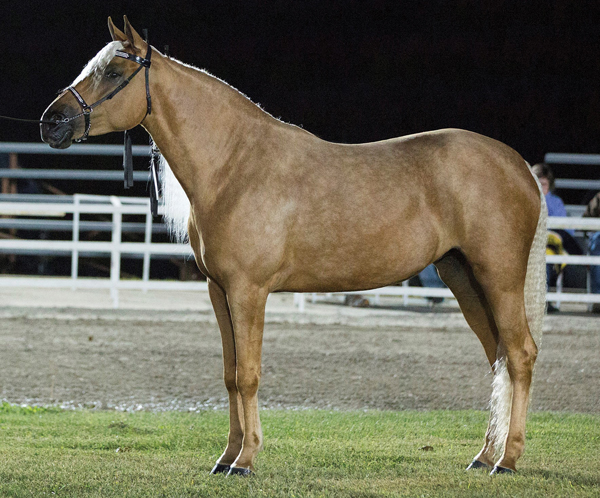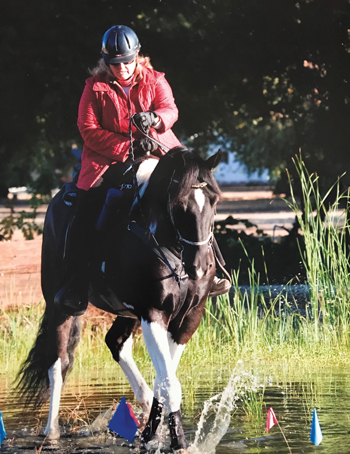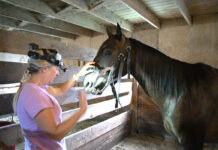
When the first settlers came to the Ozark Mountains of southern Missouri in the 1830s, the mountains were covered with forests of birch, sycamores, oaks and pines. The series of plateaus that made up this part of the mountain range were suitable for farming, and by the mid-1800s, farms growing a variety of crops had been established throughout the area. Horses were the lifeblood of these new Missourians, and they brought Arabians, Morgans and plantation horses with them to their new home in the mountains. As the need developed for a horse that could comfortably cover ground in the rugged terrain, Saddlebreds, Tennessee Walking Horses and Standardbreds were added to the mix. By the end of the 19th century, a distinct horse had developed that would soon be known as the Missouri Fox Trotter.
By the 1940s, motorized vehicles had taken over the jobs once held by horses in the Ozarks. But that didn’t mean the Missouri Fox Trotter was no longer needed. The breed had proven its worth as a comfortable and easygoing mount that could easily negotiate the most rugged of Ozark Mountain trails.
An effort was launched to preserve the Missouri Fox Trotter, and in 1948, the Missouri Fox Trotting Horse Breed Association (MFTHBA) was born.

Smooth Gaits of the Official Horse of Missouri
One of the breed’s most prized characteristics is its special gaits. The Missouri Fox Trotter has three natural gaits: the flat-footed walk, the fox trot
and the canter.
The flat-footed walk performed by the Missouri Fox Trotter is a four-beat gait where each foot is lifted and set down an in even cadence. With each stride, the back foot reaches forward and slides in as it’s set down. The gait is smooth to ride, helping the rider resist fatigue after long hours in the saddle.
The fox trot is the breed’s signature gait and is unique in that it’s diagonal. In a diagonal gait, pairs of hooves lift off and move forward together. The horse walks briskly in the front while trotting in the back.
All the while, the horse’s head nods along rhythmically with the back legs. Fox Trotters can travel as fast as 10 mph at this comfortable gait, which is easy to maintain over long distances.
Missouri Fox Trotters also have a distinct canter. The gait is performed with collection and has a rocking horse motion that is easy for the rider to sit.
Missouri Fox Trotter Jobs Today
Although this gaited breed is no longer employed in its original job of all-around farm horse, there’s still plenty of work for these horses to do. The breed is most often used as a trail horse, with 90 percent of the MFTHBA members keeping their horses for this purpose. Competitive trail riding and endurance are popular sports for this breed—not surprising given the breed’s history.
Missouri Fox Trotters are also good with cattle, and some are used for ranch work. Others are used in western performance classes or driving, both for pleasure and in the show ring.
When competing against each other, these horses are shown in model classes, where they are exhibited in hand and judged on how closely they match the breed standard for conformation. They are also evaluated on how well they perform the flat-footed walk and the fox trot.
In performance classes, Missouri Fox Trotters are judged against the breed standard for their gaits under saddle. Individual horses compete against one another in two-gait classes (flat foot walk and fox trot) or three gait classes (flat food walk, fox trot and canter).
Versatility classes for Missouri Fox Trotters include western pleasure, horsemanship, English, reining, barrel racing, pole bending and ranch horse
competitions.
Missourians are proud of their special horse, and in 2002, the breed was named the official state horse of Missouri. Their popularity has continued to grow, and they are no longer just a Southern treasure; Missouri Fox Trotters can now be found throughout the U.S. and Canada.
Missouri Fox Trotter Fast FactsHeight: 14 to 16 hands |
This breed profile on the Missouri Fox Trotter originally appeared in the September 2019 issue of Horse Illustrated magazine. Click here to subscribe!






